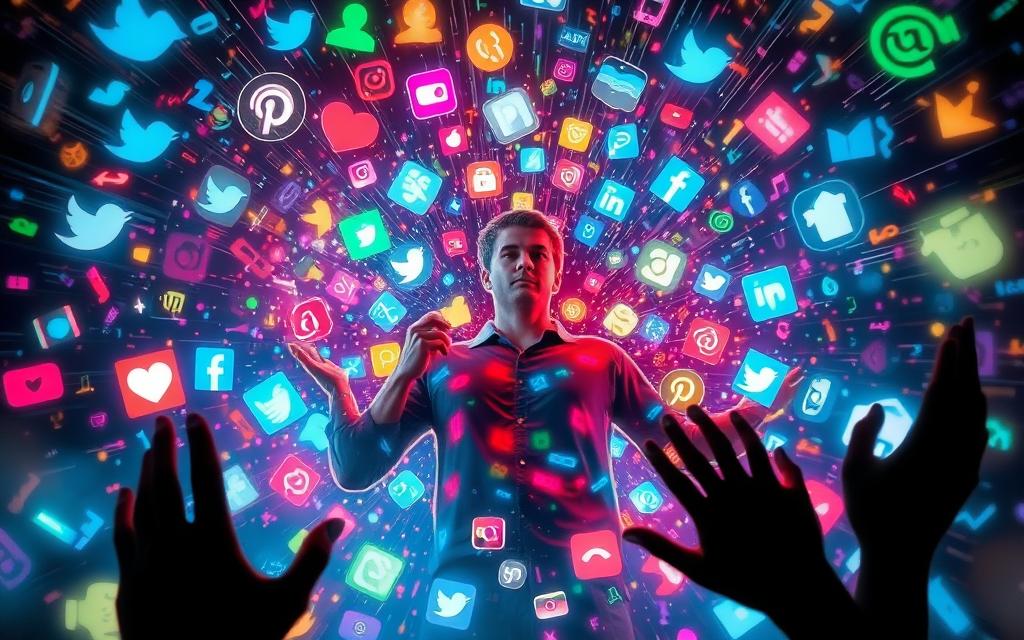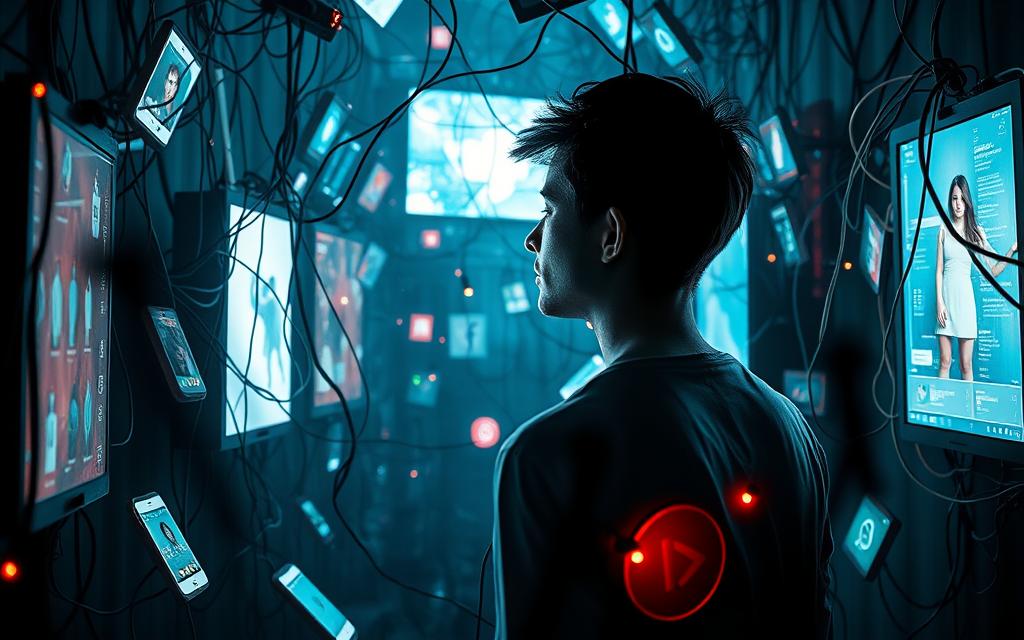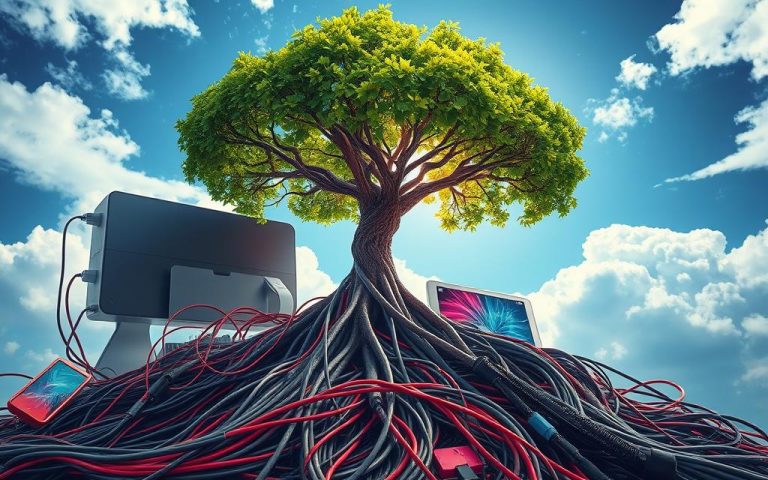The Hidden Addictiveness of Modern Technology
Technology addiction is a big problem today. Many people struggle with being too dependent on tech. Even though the US doesn’t officially call it an addiction, other countries do. This shows how serious it is.
Being addicted to technology can lead to serious issues. It can harm your mental health, make you feel lonely, and lower your productivity. We need to tackle this problem head-on.
Social media sites like TikTok and Instagram are very addictive. Tech companies use tricks to keep us hooked. This is why 44% of teens can’t live without their tech and 45% are online all the time.
Technology addiction is a big worry for young people. Spending 5 hours a day on phones can make teens twice as likely to feel depressed. This is a serious issue.
Technology addiction is a complex issue that needs our attention. By understanding why and how it happens, we can improve our relationship with tech. This article will look into the effects of tech addiction on individuals and society. We’ll discuss topics like technology addiction, tech dependency, and digital addiction.
Understanding How Technology Is Addictive: The Modern Digital Trap
Our digital lives are deeply influenced by the psychology of addiction. Tech companies use many tactics to keep us hooked. They use dopamine, a chemical linked to pleasure, to keep us engaged. This is done through rewards like likes and notifications.
Studies reveal that 6-11% of internet users in the US show signs of addiction. In some Asian countries, this number is even higher among young people. It’s clear we need to understand why tech addiction is so common and its effects on our lives. Dopamine’s role in keeping us online is key, leading to a cycle of craving and using.
The Psychology Behind Tech Addiction
Research shows tech companies use tricks to get us to spend more time online. They use bright colors, endless scrolling, and personalized content. These methods aim to keep us on platforms, often harming our mental and physical health. Knowing how tech addiction works helps us fight it and use technology in a healthier way.
The Role of Dopamine in Digital Engagement
Dopamine is key in why we enjoy digital activities. It’s released when we get likes or notifications. Tech companies use this to keep us coming back for more. By understanding dopamine’s role, we can manage our digital habits better.
| Country | Internet Addiction Rate |
|---|---|
| US | 6-11% |
| Asian countries | 10-20% |
The Evolution of Addictive Tech Design
Modern technology’s design has grown more complex. Many companies add features that make tech use addictive. This has a big impact on how we use technology, making it hard to stop using our devices.
Features like notifications and endless scrolling keep us hooked. These elements are key in making technology addictive.
Some key features of addictive technology include:
- Personalized content that is tailored to individual users
- Instant feedback and rewards for certain actions
- Endless scrolling and streaming options
These features trigger the brain’s reward system, releasing dopamine. This can create a cycle of addiction. Users become hooked on the constant flow of information and stimulation from their devices.
To fight this, we need to think about how tech design affects our lives. We should aim for a better balance between tech use and other parts of life.
Understanding how addictive tech design works can help us find ways to use technology healthier. We can work on reducing the risks of addictive technology.
| Tech Design Element | Impact on User Experience |
|---|---|
| Notifications | Increased engagement, but can distract and stress us |
| Infinite Scrolling | Provides endless content, but can lead to addiction and shorter attention spans |
The Neuroscience of Digital Dependency
Research into neuroscience has revealed how digital dependency affects our brains. Constant screen use changes brain development, mainly in the young. This leads to shorter attention spans as we struggle to focus on one thing for long.
Excessive screen time changes the brain’s structure and function. This impacts areas like attention and impulse control. Problems include shorter attention spans, more impulsiveness, and less working memory. The World Health Organization has set guidelines for children’s screen time, warning of digital dependency risks.
Digital dependency’s effect on attention spans is a big worry. The constant availability of digital media makes it hard to disconnect. This can cause stress, lower productivity, and harm overall well-being. Understanding digital dependency’s neuroscience helps us fight its effects and adopt better digital habits.
| Age Group | Screen Time | Attention Span |
|---|---|---|
| 16-24 | Every 12 minutes | Decreased |
| 25-34 | Every 20 minutes | Reduced |
| 35-44 | Every 30 minutes | Decreased |
Knowing the risks of digital dependency helps us adopt healthier digital habits. We can set screen time limits, do relaxing activities, and value face-to-face interactions. This way, we can protect our attention spans and overall well-being.
Social Media: The Perfect Storm of Addictive Elements
Social media is now a big part of our lives. People spend hours scrolling through their feeds, looking for likes, comments, and shares. These platforms use tricks to keep us hooked, often harming our mental health.
The endless stream of info and need for online engagement distracts us. It makes it hard to focus on anything else. This constant distraction is a big problem.
The impact of social media on mental health is worrying. Studies show a big rise in global depression over 30 years. Social media’s instant rewards can stop us from solving problems and delay our gratification. This can lead to many negative effects.
To fight addiction, we must understand social media’s addictive elements. We need to take steps to reduce their harm.
Some key statistics show the problem of technology addiction:
- Behavioral addictions have surged in the last 20 years.
- Global depression rates have gone up a lot in 30 years.
- People in rich countries have become less happy in the last decade.

By knowing the addictive elements of social media, we can start to break free. We can set limits on our use or find positive ways to engage online. This helps improve our mental health.
| Platform | Addictive Elements | Effects on Mental Health |
|---|---|---|
| Likes, comments, shares | Increased stress, anxiety, and depression | |
| Followers, likes, comments | Low self-esteem, body dissatisfaction, and anxiety | |
| Followers, likes, retweets | Increased stress, anxiety, and depression |
Gaming and Virtual Worlds: Understanding the Pull
Gaming and virtual worlds are getting more popular. Many people spend hours in immersive technologies and chat with others in virtual worlds. A study on online gaming addiction found that rewards and achievements can lead to addiction.
The reasons behind gaming and virtual worlds are complex. Needs like autonomy, competence, and relatedness are key. Online gaming can give a sense of competence and autonomy that’s missing in real life, leading to addiction for some.
- 2-3% of the general population suffers from gaming disorder (Pan et al., 2020; Stevens et al., 2021; Kim et al., 2022)
- Online gaming addiction is more prevalent among male users, adolescents, and young adults
- Excessive stimulus salience, mood modification, tolerance, withdrawal symptoms, conflict, and relapse are factors related to addictive behavior (Griffiths, 2005)
As immersive technologies grow, understanding gaming and virtual worlds is key. This helps avoid addiction and encourages healthy use.
The Role of Notifications in Behavioural Conditioning
Notifications are key in behavioural conditioning, leading to technology addiction. They activate the brain’s reward system, releasing dopamine. This makes users keep coming back for more, creating a cycle of addiction.
A study showed quitting Facebook for 99 days was tough. Many couldn’t make it past the first few days. This shows how addictive social media can be. Notifications on these platforms trigger addictive responses, like poker machines and games.
Some important stats on notifications and technology addiction include:
- Over 10,000 scientific papers have used “smartphone addiction” in research.
- People spent 2 hours and 27 minutes on social media daily in 2022.
- 30% of users feel anxious if they haven’t checked Facebook in two hours.
These numbers show how big a role notifications play in behavioural conditioning. They highlight the need to tackle technology addiction in our lives.
Digital Wellness and Mental Health Impact
Looking into how tech addiction affects our minds shows us how important digital wellness is. It helps us stay balanced. Studies warn of a strong connection between tech use and anxiety, depression, and sleep problems.
Research points out that social media can increase the risk of depression and anxiety. It also affects self-esteem and body image negatively.
A study by Primack et al. (2017) found that using many social media sites can lead to depression and anxiety in young adults in the US. Twenge et al. (2018) also found that more screen time is linked to more depression, suicidal thoughts, and suicide among teens in the US. These findings stress the importance of digital wellness to fight the bad effects of tech on mental health.
To support digital wellness and mental health, finding a balance is key. We can do this by setting limits, doing things offline, and getting help when needed. By focusing on digital wellness and mental health, we can lower the risk of anxiety and other mental health problems caused by tech addiction.
Breaking the Cycle: Practical Steps to Digital Freedom
Getting digital freedom means fighting technology addiction. It’s about taking practical steps to control tech use. Setting limits is key, like making tech-free zones and using screen time tools.
Becoming more aware of how we use tech is vital. We can do this by tracking our internet use, finding out what makes us use tech too much, and doing other things like hobbies or exercise. There are also apps that help by tracking our use, blocking bad sites, and locking devices.
Here are some practical steps to think about:
- Creating a tech-free zone in the home
- Setting screen time limits for yourself and your family
- Engaging in physical activity or hobbies to reduce screen time
- Seeking support through support groups or professional counseling
By following these practical steps, we can beat technology addiction. This leads to a healthier balance between tech use and life’s other joys. It brings us closer to true digital freedom.

| Strategy | Description |
|---|---|
| Setting boundaries | Creating device-free zones and using screen time features |
| Mindfulness practices | Logging internet use, identifying triggers, and engaging in alternative activities |
| Leveraging technology | Using apps to monitor usage, block distracting sites, and utilize device lock features |
Mindful Technology Usage Strategies
Using technology mindfully is key in today’s world. Being intentional with our tech use helps us avoid too much screen time. It also helps us have a better relationship with technology. We can do this by setting digital limits, watching how we use apps, and making tech-free areas.
Setting digital limits is vital for a healthy balance. We can do this by setting times for tech use and sticking to them. For example, not using screens before bed can help us sleep better and avoid sleep problems.
Digital Boundaries Setting
Creating tech-free zones is another smart move. This means making some places, like the dinner table or living room, screen-free. It helps us do things that don’t involve technology, like reading or spending time with loved ones.
App Usage Monitoring Tools
Using tools to track app use can also help. These tools show how much time we spend on different apps. They help us set goals to use our screens less. Being more aware of our tech use helps us develop better habits and avoid the dangers of too much technology.
Creating Tech-Free Zones
Having tech-free zones has many benefits. It reduces distractions, improves focus, and boosts productivity. By making some areas tech-free, we can work or study without distractions. This improves our well-being and helps us avoid tech addiction.
By using these strategies, we can use technology more mindfully. This reduces the risks of too much screen time and helps us find a better balance in life. It can lead to better mental and physical health, more productivity, and a more fulfilling life.
Rebuilding Real-World Connections
Overcoming technology addiction means focusing on real-world connections. We need to nurture relationships and engage in activities that help with dopamine balance. It’s also important to develop social skills for a balanced life.
Too much tech can cause social isolation and lower attention span. It also reduces our ability to communicate face-to-face. To fix this, we must balance tech use with real-life interactions. This can be done by setting aside time without devices, trying new hobbies, and joining community activities.

Here are some ways to boost dopamine balance and strengthen real-world connections:
- Joining a sports team or club
- Volunteering for a cause you’re passionate about
- Taking a cooking class or art workshop
- Attending community events or concerts
Alternative Activities for Dopamine Balance
Doing activities that help with dopamine balance can reduce tech addiction. Try meditation, yoga, or spending time outdoors. These activities can help regulate dopamine and reduce addiction risks.
Social Skills Rehabilitation
Building real-world connections means improving social skills. Practice listening, empathy, and clear communication. Face-to-face interactions and group activities can strengthen these skills and create deeper relationships.
The Future of Ethical Tech Design
Looking ahead, ethical tech design is key to our future. The rise of technology addiction worries us. But, ethical tech design can help us use tech better.
Big names like Apple and Google are leading the way. They’ve introduced tools to help us manage our screen time. Instagram is also helping users take breaks from endless scrolling. These moves show a shift towards making tech better for us, not just for profit.
Here are some ways to make tech more ethical:
- Design tech that brings people together
- Help users focus on what’s important, not just material things
- Give tools to control how much tech we use
The future of tech is exciting. It could bring us closer together, not push us apart. We must focus on ethical tech design to make tech healthy and balanced. This way, we can build a better future for all.
| Company | Initiative |
|---|---|
| Apple | Data dashboards to monitor screen time |
| Reminders to inform users about their screen time | |
| Features to encourage users to take breaks from their feeds |
Conclusion: Embracing a Balanced Digital Life
As we conclude our journey into the hidden addictiveness of modern tech, a clear path emerges. We must embrace a balanced digital life. The digital world has changed our lives, but we must control our tech use and focus on our mental health.
Statistics show digital addiction affects many, with a rise in excessive tech use. This has led to more anxiety, depression, and stress. It also makes us less productive due to distractions from notifications and social media.
But there’s hope. Digital detox, setting screen time limits, and using tech mindfully can help. By taking back control, we can use tech wisely and protect our mental health.
Let’s strive for a balance between our digital and physical lives. Mindfulness, real connections, and autonomy are key. We can make the most of tech while living a balanced, fulfilling life. The future is ours to shape, starting with our digital habits.
FAQ
What is technology addiction?
Technology addiction is when people can’t stop using digital devices. It harms their health, mind, and social life.
What are the causes of technology addiction?
It’s caused by dopamine release, rewards, and tech companies’ tricks. They use these to keep users hooked.
How have tech companies designed technology to be more addictive?
Companies have added features like infinite scrolling and autoplay. They also use notifications to keep users engaged.
How does technology affect the brain?
Too much screen time changes the brain. It affects attention and reward systems. This can harm mental health and thinking skills.
What is the role of social media in technology addiction?
Social media uses likes and comments to keep users hooked. This can harm mental health.
How do gaming and virtual worlds contribute to technology addiction?
Games and virtual worlds use rewards and social connections. They make digital experiences highly engaging and addictive.
How do notifications contribute to technology addiction?
Notifications trigger dopamine release. They make users keep using digital devices, leading to addiction.
What are the mental health impacts of technology addiction?
Addiction to tech can cause anxiety, depression, and sleep problems. It shows how much digital use can harm mental health.
How can individuals break the cycle of technology addiction?
To break the cycle, set digital limits and find a balance. Seek help to control your digital use.
What are some mindful technology usage strategies?
Use digital limits, track app use, and make tech-free zones. These strategies help maintain a healthy tech relationship.
How can individuals rebuild real-world connections?
Engage in activities outside tech, improve social skills, and join community projects. This helps counteract tech’s isolating effects.
What is the future of ethical tech design?
Ethical tech design will focus on user well-being. It aims to create technology that supports healthy digital habits, not addiction.







